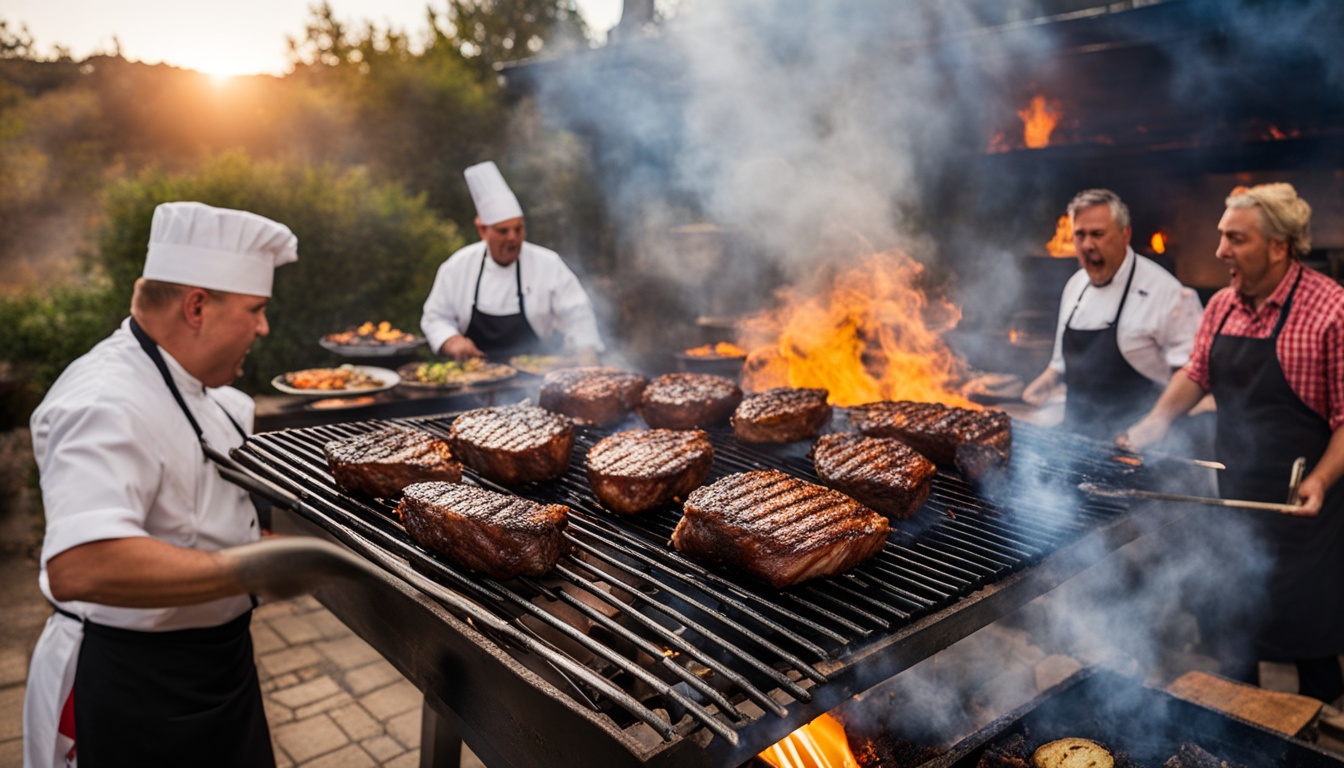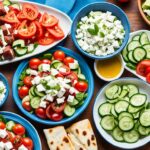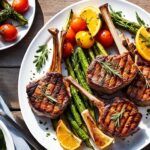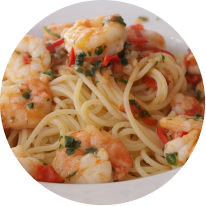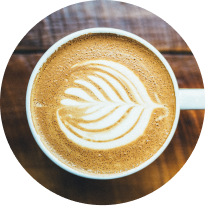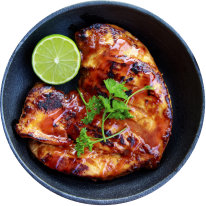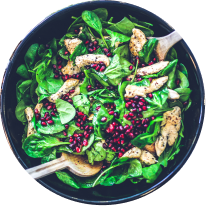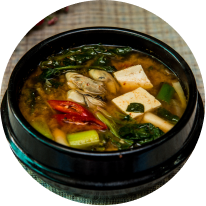Have you ever wondered how renowned chefs and passionate home cooks achieve that captivating smoky flavor and charred texture in their dishes? The secret lies in the art of open flame cooking. This primal method of cooking with natural elements has experienced a resurgence, as more people seek to reconnect with the roots of culinary tradition and create unforgettable outdoor dining experiences. But what are the keys to mastering this age-old technique, and how can you bring the magic of live-fire cuisine into your own kitchen or campsite? Dive in and let’s explore the world of open flame cooking together.
Key Takeaways
- Open flame cooking techniques like grilling, barbecuing, and smoking can elevate the flavor and texture of your dishes.
- Choosing the right type of wood, such as aspen, poplar, or spruce, is crucial for creating the perfect cooking environment.
- Understanding key terms like “plancha,” “smoker,” and “hearth” can help you navigate the world of open flame cooking.
- Mastering open flame cooking can bring a unique and primal dining experience to your kitchen or campsite.
- Incorporating open flame techniques can help chefs and home cooks alike layer flavors in their dishes more effectively.
The Art of Building the Perfect Campfire
Crafting the perfect campfire is the foundation for successful campfire cooking and outdoor cooking. Whether you’re whipping up a delectable meal over an open flame or simply gathering around the warm glow, mastering the art of fire building is essential for a safe and enjoyable experience in the great outdoors.
Choosing the Right Spot for Your Fire
The first step in building a sustainable and controllable fire is selecting the appropriate location. Look for a level, fire-safe area away from overhanging branches, dry vegetation, or other potential fire hazards. Utilizing existing fire rings or fire pans can help minimize your impact on the environment and adhere to Leave No Trace principles.
Constructing a Sustainable and Controllable Fire
To construct a sustainable fire, begin with small twigs and gradually add larger sticks and logs as the fire grows. This gradual approach allows the fire to burn down evenly, providing a consistent and manageable heat source for outdoor cooking. Proper fire management is crucial for maintaining a safe and controllable blaze.
Fire Safety and Leave No Trace Principles
Safety should always be the top priority when building a campfire. Ensure you have a bucket of water or sand nearby to extinguish the fire if needed, and never leave your fire unattended. Following Leave No Trace principles is essential for responsible campfire cooking and minimizing your impact on the natural environment.
“The art of building a campfire is not just about creating a warm glow; it’s about respecting the outdoors and leaving it better than you found it.”
By choosing the right location, constructing a sustainable fire, and adhering to safety and environmental best practices, you can master the art of building the perfect campfire and take your outdoor cooking experience to new heights.
Essential Tools for Open Flame Cooking
When it comes to mastering open flame cooking, having the right equipment is crucial. From durable cast iron cookware to versatile outdoor cooking tools, the right tools can make all the difference in your culinary adventures over an open fire.
Cast Iron Cookware: Skillets and Dutch Ovens
Cast iron skillets and Dutch ovens are the unsung heroes of open flame cooking. These heavy-duty pieces of cast iron cookware can withstand the high heat of an open fire, making them perfect for a variety of cooking techniques, from searing and sautéing to baking and slow cooking. The natural non-stick properties of cast iron allow you to effortlessly cook everything from delicate fish to hearty stews.
Roasting Sticks, Skewers, and Tongs
In addition to cast iron cookware, outdoor cooking tools like roasting sticks, skewers, and tongs are essential for handling food directly over the flames. Roasting sticks with heat-resistant handles make it easy to cook items like hot dogs, marshmallows, and kebabs without risking burns. Metal skewers are perfect for grilling vegetables, meats, and even fruits, while heat-resistant tongs, spatulas, and spoons allow you to flip, stir, and serve your culinary creations with ease.
| Tool | Use |
|---|---|
| Cast Iron Skillets | Searing, sautéing, frying |
| Dutch Ovens | Baking, slow cooking, braising |
| Roasting Sticks | Cooking hot dogs, marshmallows, kebabs |
| Skewers | Grilling vegetables, meats, fruits |
| Tongs | Flipping, stirring, serving food |
By investing in the right cast iron cookware and outdoor cooking tools, you’ll be well on your way to mastering the art of open flame cooking and unlocking a world of flavorful, adventurous meals.
Mastering open flame cooking techniques
When it comes to outdoor cooking, harnessing the power of open flames offers a world of flavorful possibilities. From the sizzling char of grilled meats to the moist, aromatic delights of foil packet cooking, mastering these techniques can elevate your campfire cuisine to new heights.
Direct Cooking: Grilling and Roasting
Direct cooking, where food is placed directly over the fire, is a classic open flame method that is perfect for grilling steaks, burgers, and other items that benefit from a charred, caramelized crust. This method requires close attention to hot spots and adjusting the cooking position to ensure even heating. The key to successful direct cooking is maintaining a consistent temperature and monitoring the food closely to prevent overcooking.
Roasting over an open flame is another rewarding open flame cooking technique. Whether you’re roasting whole chicken, vegetables, or even bread, the intense heat of the fire can create a delightful exterior while locking in moisture and flavor. Careful placement and rotation of the food are essential for achieving a well-rounded, evenly cooked result.
Foil Packet Cooking for Moist and Flavorful Meals
Foil packet cooking is a versatile open flame technique that helps retain moisture in dishes like fish, vegetables, and small cuts of meat. By tightly sealing the food in aluminum foil, you can create flavorful, self-contained meals that are easy to cook over the campfire. The foil packets help to steam the ingredients, infusing them with the essence of the fire and any herbs, spices, or marinades you’ve added.
Foil packet cooking is a great option for busy campers or those looking to minimize cleanup, as the entire meal is cooked and served in the same foil packet. It’s also an excellent way to experiment with different flavor combinations and cooking methods, as the closed environment of the foil packet allows the ingredients to meld together seamlessly.
| Open Flame Cooking Technique | Key Benefits | Best Used For |
|---|---|---|
| Direct Cooking (Grilling and Roasting) | – Achieves a charred, caramelized crust – Requires close attention to hot spots and even heating |
– Steaks, burgers, and other meats – Whole chicken, vegetables, and bread |
| Foil Packet Cooking | – Retains moisture and flavor – Minimizes cleanup |
– Fish, vegetables, and small cuts of meat – Experimenting with different flavor combinations |
By mastering a variety of open flame cooking techniques, you can unlock a world of delicious and versatile outdoor meals. Whether you’re grilling, roasting, or cooking in foil packets, the key is to experiment, adjust, and embrace the unique character that open flame cooking brings to your culinary adventures.
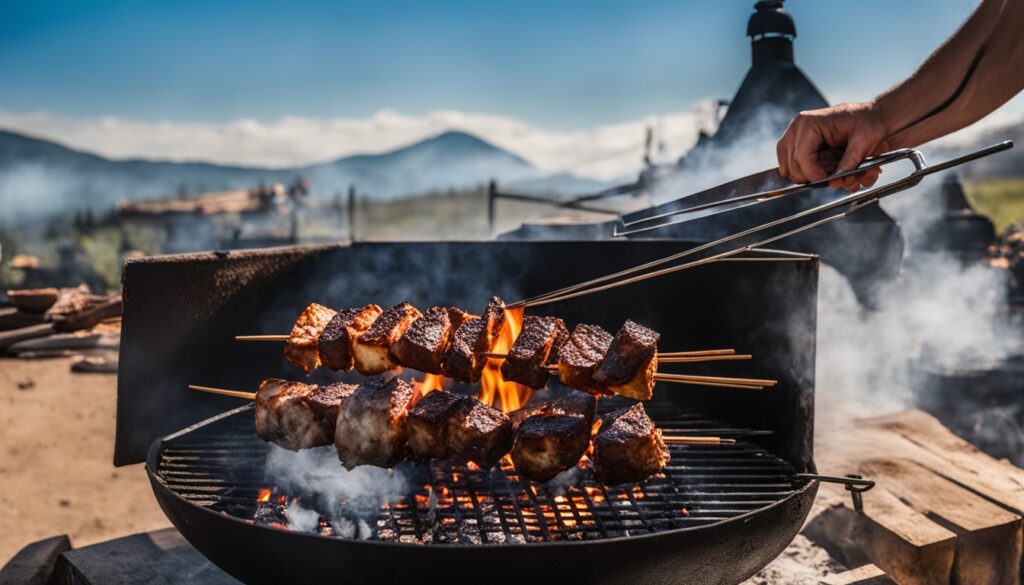
Unleashing Flavor with Wood and Smoke
The type of wood used in wood-fired cooking can have a significant impact on the flavors imparted in the food. It’s important to avoid dense, hard woods like maple and oak, as they can be difficult to control and may produce an overwhelming smoky taste. Instead, opt for woods like aspen, poplar, willow, spruce, and pine, which burn more quickly and leave behind less charcoal.
Choosing the Right Wood for Smoking
When it comes to smoking, the key is to carefully control the temperature and smoke levels. Start with a few smaller pieces of wood, such as Kiawe, Ironwood, Lychee, Mango, or Strawberry Guava, and gradually add more as needed to maintain a consistent, low-and-slow heat. Soaking the wood chunks for at least 30 minutes to an hour can help produce a more flavorful smoke instead of burning too quickly.
Controlling Temperature and Smoke Levels
To develop rich, smoky flavors without overwhelming the dish, it’s essential to monitor the grill temperature closely. The AutoIgnite Series 545 Digital Charcoal Grill and offers a temperature range from 250°F to 650°F, with the QuickSear™ Cast Iron Sear Plate/ Hopper Lid being able to reach even higher temperatures. Grilling is typically done in the 350 to 500-degree range, while searing ranges from 300-500 degrees and roasting from 300-400 degrees. Smoking, on the other hand, involves temperatures that typically range from 225-250 degrees and can be maintained for up to 5 hours or overnight for more intense smoke flavor.
To ensure the food reaches the appropriate internal temperature for safety and optimal flavor, it’s recommended to use a meat thermometer. Additionally, incorporating a water pan in the grill can help maintain moisture and prevent the food from drying out during the smoking process.
“Mastering open flame cooking techniques can elevate outdoor cooking skills and challenge users to explore new grilling methods.”
By carefully selecting the right wood, controlling the temperature, and managing the smoke levels, you can unlock a world of wood-fired cooking, smoking, temperature control, and smoke flavor in your outdoor cooking adventures.
Delicious Campfire Recipes to Try
Embracing the art of open flame cooking opens up a world of delicious and versatile recipe possibilities. From classic campfire nachos to creative s’mores, the options for savoring the flavors of the great outdoors are truly endless.
Campfire Nachos and Foil Packet Potatoes
Campfire nachos are a crowd-pleasing favorite, made by layering tortilla chips, melted cheese, savory beans, and your choice of toppings in a cast-iron skillet or Dutch oven. The beauty of this dish lies in its simplicity – just assemble the ingredients, place the skillet or Dutch oven directly on the coals, and let the heat work its magic. For a complementary side dish, try foil packet potatoes, where cubed potatoes are seasoned with herbs and spices, wrapped in foil, and cooked right alongside the nachos.
Skillet Pizza and Dutch Oven Chili
If you’re in the mood for something more substantial, consider whipping up a skillet pizza or a hearty Dutch oven chili. The cast-iron cookware excels at retaining and distributing heat, making it the perfect vessel for baking a crispy, golden-brown pizza crust or simmering a flavorful chili. Top the pizza with your favorite toppings, or let the chili simmer over the coals, filling the air with the aroma of spices and simmering beef.
S’mores with a Twist
No campfire experience is complete without the classic s’mores. While the traditional graham cracker, chocolate, and marshmallow combination is a timeless delight, you can also get creative with this iconic dessert. Try using alternative crackers or cookies, gourmet chocolate varieties, or even flavored marshmallows to put a unique spin on this beloved campfire treat.
Whether you’re in the mood for a quick and easy meal or a delectable dessert, these open flame cooking techniques and recipes are sure to elevate your next outdoor adventure. Embrace the primal joy of cooking over a campfire and savor the flavors of the great outdoors.
The Joy of Unplugged Outdoor Cooking
In today’s fast-paced, technology-driven world, the allure of outdoor cooking lies in the primal satisfaction of cooking with natural elements and creating a memorable dining experience in the great outdoors. Unlike modern, high-tech cooking methods, unplugged cooking encourages a slower, more mindful approach, where you rely on your senses and intuition rather than timers and thermometers.
This nature-based cooking allows you to reconnect with the natural world, hone your culinary skills, and enjoy the warmth and ambiance of a crackling campfire cooking. Whether you’re an experienced outdoor chef or a newcomer to the world of live-fire cuisine, mastering open flame cooking techniques can transform your camping trips and backyard gatherings into unforgettable culinary experiences.
From the sizzle of grilled meats to the aroma of smoky vegetables, the joy of unplugged outdoor cooking is a sensory delight that connects you to the natural world in a profound way. By embracing this primal culinary adventure, you can unlock a deeper appreciation for the simple pleasures of life and create lasting memories with friends and family.




